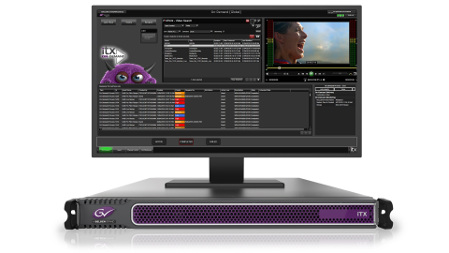SaaS Continues to Evolve for Video Production
ALEXANDRIA, VA.—The cloud continues to redefine the way that broadcasters and video production facilities are doing business as content moves from internal networks to offsite servers, while software as a service, or SaaS, is increasingly being used by both consumers and businesses alike. Cloud-based services such as Salesforce.com and Microsoft’s Office365 have changed the way software is used—offering subscriptions and pay-as-you go solutions over upfront purchases. Video streaming services such as Netflix have successfully competed with physical media content, while in the process being available on a plethora of devices.

Grass Valley debuted iTX On Demand at the 2016 NAB Show.
For broadcasters and video production facilities, this transition to SaaS can present new opportunities as well as a few challenges. While it means replacing older systems for cloud-based solutions, SaaS promises to offer greater scalability, potentially lower operating cost and even off-site backups and archiving of content. Getting everyone on board—or rather to the cloud—could remain the biggest challenge however.
“There is no reason everything can’t or won’t be an SaaS app in time,” said Al Kovalick, founder of Media Systems Consulting in Santa Clara, Calif. and cloud columnist for TV Technology. “What is holding it back is the existing programs that run on monolithic servers and workstations. The user interface also has to be HTML 5 to run in a browser, and it is already apparent not everyone is going to make that move anytime soon.”
One notable misconception about SaaS is that everything suddenly has to be moved to the cloud.
“That is not the case,” added Kovalick. “Just because it is an SaaS app doesn’t mean it has to run in the cloud. Clients can buy an SaaS app and put in on the Amazon Cloud or even a local server. It really just provides flexibility.”
COST FLEXIBILITY
Get the TV Tech Newsletter
The professional video industry's #1 source for news, trends and product and tech information. Sign up below.
As today’s budget belts continue to tighten, and facilities are forced to do more with less, SaaS could be a good fit, especially for those who need greater financial flexibility.
“We see SaaS as a solution where there are concerns over upfront costs,” said Scott Rose, senior director of product management for digital media at Grass Valley. “It works where the applications may be variable as well, or you don’t need it every month. If you are processing content or editing a variable amount, SaaS is a good solution as you only pay for what you consume.”
To address this changing workflow Grass Valley recently introduced iTX On-Demand, a new VOD/OTT solution that automates the VOD process while dramatically reducing prep time for both pre-recorded and live productions. It is available as an option with Grass Valley’s iTX Integrated Playout Platform, but can also be used alongside third-party playout solutions.
“This allows a broadcaster to take content and make it available for an on-demand platform,” said Rose. “It makes good sense for it to be through SaaS as the amount of VOD content can be wildly different throughout the year. If you knew the number of hours you’d use a solution it would make sense to build a system to do that job, but if you need to urgently scale at certain times then the SaaS model makes a lot of sense.”
TRANSCODING IN THE CLOUD
This year IBM-owned Aspera introduced new capabilities for its Aspera Files SaaS platform, including the Aspera Drive 2.0, which added sharing, distribution and exchange features to the desktop, and Aspera Files Mobile, which enabled clients to utilize Files Dropboxes from Apple iOS and Google Android devices over Wi-Fi and cellular networks. This new functionality builds upon Aspera FASP technology.

Francois Quereuil, senior director of worldwide marketing at Aspera
Aspera files is designed to improve bandwidth, according to Francois Quereuil, senior director of worldwide marketing at Aspera. “Aspera Files can be used to share and distribute content internally or with a third party,” he said.
The ability to use a cloud-based application could have other advantages beyond scalability and archiving. SaaS could also leverage cloud computing and infrastructure to transcode content for different devices.
Numerous vendors have offered solutions that include the ability to do encoding jobs with media that is or will be a cloud-resident. This includes Telestream Cloud, which debuted at the 2016 NAB Show as a video encoding SaaS that features support for the popular Apple ProRes video format, along with high-quality video transcoding for all formats and codecs, while also dynamically scaling response to customer requirements.
“All cloud services offer two things: compute and storage. For storage, Telestream Cloud is an attractive encoding service because, unlike other cloud services, it’s storage agnostic, ” said Shawn Carnahan, CTO for Telestream. “It supports the most common storage options, and now includes Aspera uploads.”
The other advantage of Telestream Cloud is in its ability to provide the encoding service near stored files. “Since it runs on any cloud, the compute encoding engine is in proximity to the storage, increasing speed and lowering costs,” added Carnahan. “Telestream Cloud allows users to encode the video while it's being distributed and stored.”
This ability to transcode in the cloud is something that is being seen necessary given that content consumption isn’t limited to the big screen in the living room.
“The cloud is particularly well-suited to providing content that can be seen on numerous devices; think of how Netflix has to send out content to a range of devices,” said Aspera’s Quereuil. “SaaS apps can be used to crunch in different formats, but also add watermarking and color correction. This can help with the entire production process.”
The changing nature of content also makes SaaS very desirable, added Steve Smith, CTO for cloud at Imagine Communications in Dallas.
“The dynamic for how content is consumed has changed a lot in the past 10 years,” he explained. “Not only is their time and location shifting, but there has been an explosion of content providers, not all of which are 24/7. Some come and go, and SaaS offers this flexibility.”
OPEN SOLUTIONS
Unlike with many past proprietary technologies an advantage of many SaaS solutions is the ability to work with multiple cloud service providers including Google Cloud Platform, Amazon Web Services and Rackspace, among others. This could ensure the flexibility that today's clients seek when opting to utilize the cloud, while options to use a private cloud and remote desktop could streamline the production process.
File sharing services such as Signiant’s Media Shuttle have also made the transferring of content as easy as dragging and dropping to a web page.
“With Media Shuttle, files are actually kept locally, yet our customers can leverage the transcoding services; and this can reduce power consumption,” said Michael Nash, senior product manager for Media Shuttle at Signiant in Lexington, Mass. “The cloud economy is thus one of scale. This is making it easier for companies to move large files, and the larger the files the more they need us.”
However, there are concerns that by utilizing an off-site technology, outages could become an issue. Whether this is overstated is still being debated.
“Workstations can also go down,” noted Kovalick. “People talk about the cloud as if it is the problem when there are connectivity issues, but to mitigate the problem you have to realize there are other ways to get that content. SaaS can thus be as reliable as anything else.”
In the short term there may still be hold outs, and that is to be expected, as this regularly occurs in times of transition.
“The broadcasting business has always been about making investment in technology and equipment, so we don’t expect to see a lot of facilities gutting the server room in the near future,” added Grass Valley’s Rose. “This move to the cloud will come more slowly; this is evolution not a revolution.”
